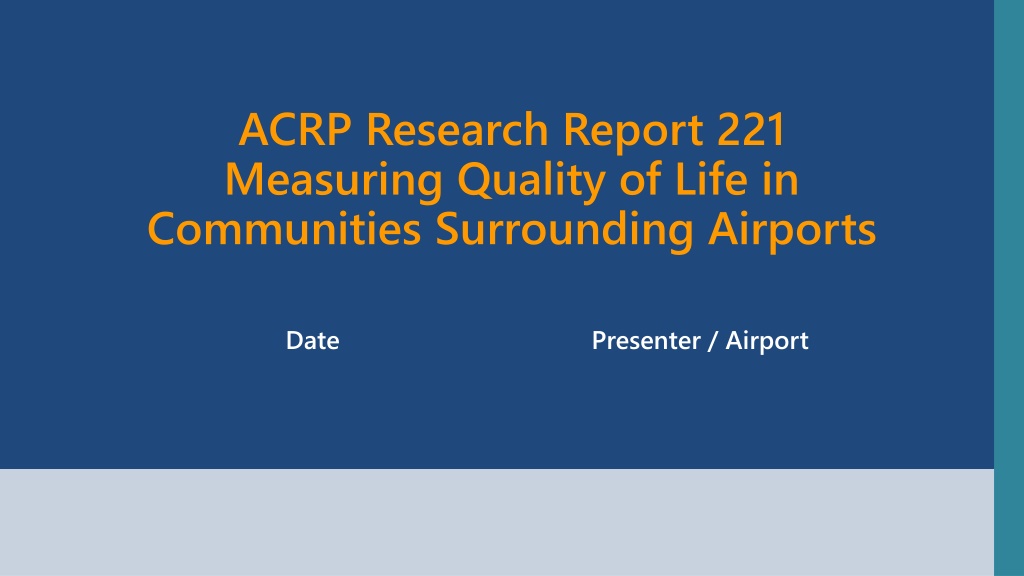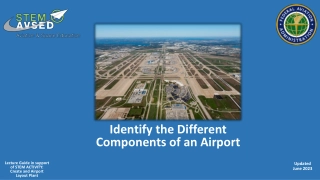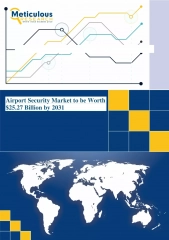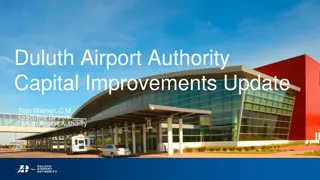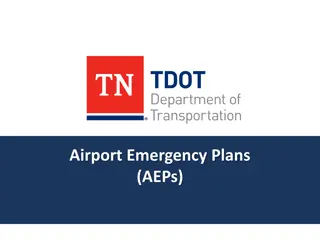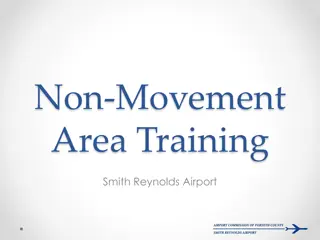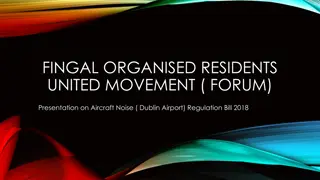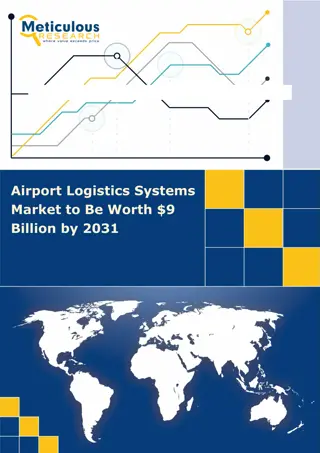Measuring Quality of Life in Airport Communities
This report delves into methods to assess the impact of airports on the quality of life in surrounding communities, exploring the diverse factors that influence individuals' well-being.
Download Presentation

Please find below an Image/Link to download the presentation.
The content on the website is provided AS IS for your information and personal use only. It may not be sold, licensed, or shared on other websites without obtaining consent from the author.If you encounter any issues during the download, it is possible that the publisher has removed the file from their server.
You are allowed to download the files provided on this website for personal or commercial use, subject to the condition that they are used lawfully. All files are the property of their respective owners.
The content on the website is provided AS IS for your information and personal use only. It may not be sold, licensed, or shared on other websites without obtaining consent from the author.
E N D
Presentation Transcript
ACRP Research Report 221 Measuring Quality of Life in Communities Surrounding Airports Date Presenter / Airport
Agenda 1. Airport Cooperative Research Program (ACRP) and Quality of Life (QOL) Assessment Overview 2. QOL Assessment objectives 3. QOL context in your airport community 4. QOL assessment framework 5. QOL indicator example 6. QOL data analysis 7. Discussion 2
1. Overview - ACRP The Airport Cooperative Research Program (ACRP) is an applied research program under the Transportation Research Board, which is part of the National Academy of Sciences ACRP undertakes research to develop ready-to-use research products to address challenges and improve practice in the airport industry on topics such as: safety, operations, environment, design, construction ACRP receives funding from the Federal Aviation Administration Projects are selected for funding by the ACRP oversight committee Research is overseen by a panel of volunteer industry experts 3
1. Overview ACRP ACRP recognized that airports often seek to understand how they affect and benefit their surrounding communities through economic or environmental studies. However ACRP identified a need for guidance to help airports develop more comprehensive assessments of their impacts. In 2020, ACRP published a report titled Measuring Quality of Life in Communities Surrounding Airports (ACRP Research Report 221) to meet this need. 4
1. Overview What is Quality of Life? The World Health Organization defines QOL as: Individuals perception of their position in life in the context of the culture and value systems in which they live and in relation to their goals, expectations, standards and concerns. It is a broad ranging concept affected in a complex way by the person's physical health, psychological state, level of independence, social relationships, personal beliefs and their relationship to salient features of their environment 5
1. Overview: Objective of ACRP Research Report 221 What is the purpose of the ACRP report? The objective of this publication is to provide methods and guidance to measure the effect of an airport on the quality of life on its surrounding communities 6
2. QOL Assessment Objective Why is this important? Airports often robust community outreach / public engagement / government relations efforts, but they may not be coordinated with all other areas of airport operations to gain a complete understanding of how airport decisions affect the community Airport activities can impact aspects of public QOL in both a positive and negative manner A comprehensive assessment can help illustrate to the airport both direct and indirect ways in which they can affect or influence QOL 7
2. QOL Assessment Objective Why is this project important (continued)? Provide airports a tool for measuring QOL components in the context of their community over time Allow for additional in-depth engagement with community stakeholders (including local governments) Demonstrate airport awareness and consideration of their effects on their neighbors and can be used as a planning tool 8
2. QOL Assessment Objective The QOL Assessment described in the report can be tailored to individual airports needs. The report provides guidance which: Enables airports to collect data on the diverse components that comprise QOL Provides a methodology for measuring these components in the community context Allows for in-depth engagement with community stakeholders 9
3. QOL Context in the Community Setting the stage: The Airport s role in the community, overall impacts? What does quality of life mean to you and your community? Who / what is your community? Key issues, concerns, priorities? What is occurring within your community that affects quality of life (positive or negative)? 10
4. QOL Assessment Methodology The QOL Assessment Methodology involves collecting information on various components of quality of life: Quantitative data (such as population, average income, air quality index, crime statistics, etc.) will be gathered from publicly available datasets Qualitative information will be gathered via an anonymous survey This is a mixed methods approach The methodology is tiered, so the airport can start with steps 1 and 2 before undertaking a full assessment 11
4. QOL Assessment Methodology There are a total of 100 indicators in the QOL Assessment Methodology, organized into 6 categories: Environmental Economic Health Local Governance / Community Services Social Relationships Transportation 12
4. QOL Assessment Methodology Step 1 Initiate the QOL dialogue internally Step 2 Engage stakeholders Step 3 Determine study area and gather quantitative data Step 4 Administer survey Step 5 Analyze data Step 6 Review or update study 13
Six Steps of QOL Assessment Methodology Airports can decide how far to go Benefits accrue even at steps 1 and 2 Increased coordination and communication internally and with external stakeholders Improve community relationships Additional information for decision makers 14
4. QOL Assessment Methodology In step 3, airport gathers quantitative data In step 4, survey participants will be asked to answer questions pertaining to qualitative indicators and asked their opinion on how important each indicator is to their or their community s overall QOL This allows the indicators to be weighted appropriately as not every indicator is equally important to an individual s or community s overall QOL 15
5. QOL Indicator Example Example of Qualitative Indicator from the Survey and Importance Score: E3: Ability to afford unexpected expenses If you had an unexpected emergency expense of $400, how much of a burden would it be? A large burden A moderate burden A small burden No burden How important do you feel this indicator is to your overall quality of life? 1. Not at all 2. A little 3. Somewhat 4. Extremely 16
6. QOL Data Analysis Results from the survey can be aggregated into a graph in the form of quadrants. Information is displayed along two axes: The X axis is the QOL score of each indicator from a high (4) on the left to low QOL score (1) on the right The Y axis is the mean importance score for each indicator score from low importance (1) on the bottom to high importance (4) on the top 17
7. Discussion 1) How do you envision a tool like this being used? 2) Do you think a QOL assessment undertaken by the airport will be valuable? 3) Would you be willing to participate in a QOL assessment in the future? 4) What opportunities do you see in understanding the perspectives of constituencies in the community that you don t normally work with? 5) Who do you think are the key stakeholders for Step 2 of the Assessment? 6)Any questions / comments? 19
End 20
